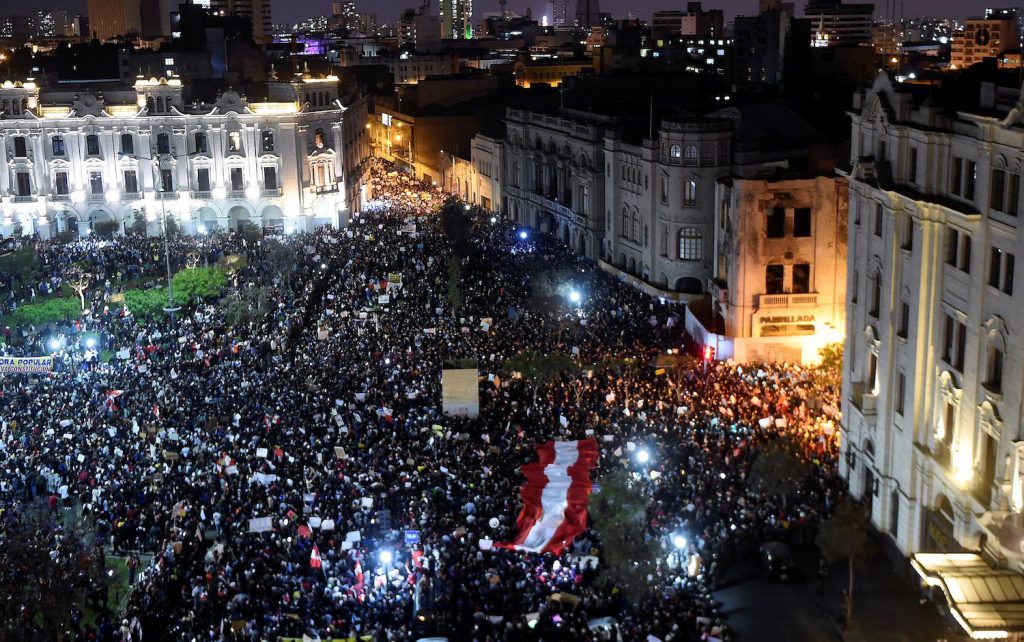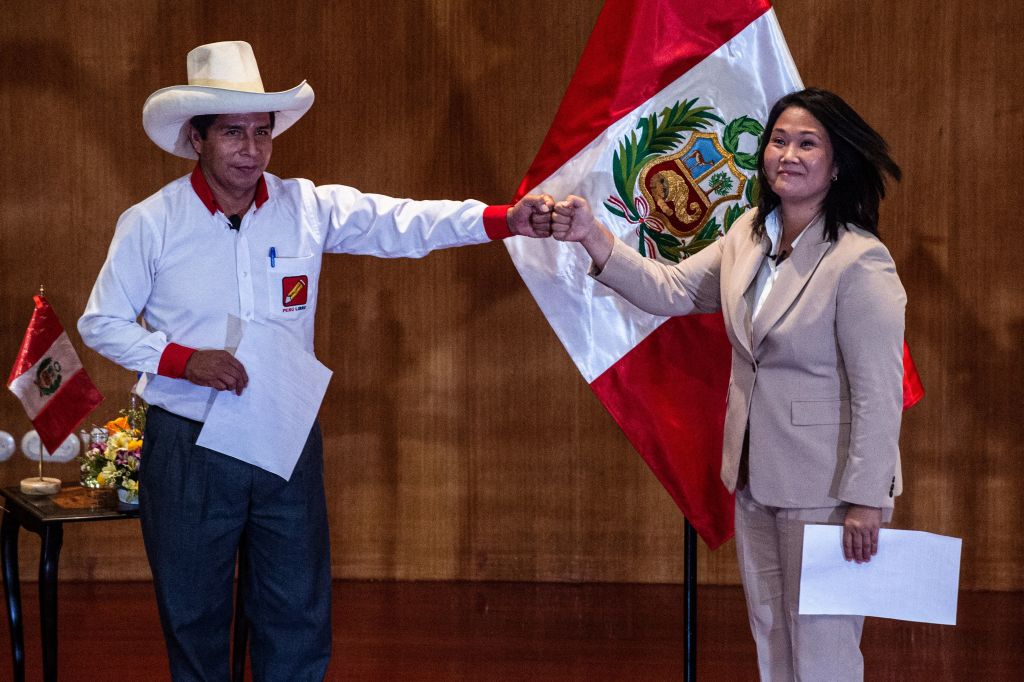“The State” Is a Story We Tell Ourselves

When the far-left candidate Pedro Castillo won the presidential election in Peru this June, he beat out right-wing candidate Keiko Fujimori with a narrow margin of around 44,000 votes.
After the election, Fujimori, the daughter of former dictator Alberto Fujimori, refused for weeks to accept the results. Though authorities and international observers found no evidence of wrongdoing, she claimed electoral fraud and attempted to get a few hundred thousand votes—mostly from impoverished, rural areas that heavily favored Castillo—thrown out. Some feared that Fujimori was leading a “slow-moving coup” to prevent Castillo from taking power.
On Monday, more than a month after the election, officials finally declared Castillo president-elect—though Fujimori has continued to call his victory “illegitimate.”
These events continue the political turmoil of the past year, during which Peru’s commitment to the rule of law has been deeply thrown into question. Fujimori’s refusal to concede defeat to Castillo would have been the second coup attempt at the highest levels of government in less than a year.
This July 28—the day Castillo is set to be sworn into office—marks the 200th anniversary of Peru’s independence from Spanish rule. But after two centuries as an independent state, my home country seems to still have much to learn about the democratic principles of a republic.
As an anthropologist who studies state politics in Peru, these recent upheavals reveal something that many Peruvians have long known: The state, with its supposed commitment to neutrality, democracy, and law, is not what it appears to be. While state officials and lawmakers claim to act for the common good, most Peruvians recognize that, in practice, their actions are driven more by business and political interests.
Last fall, widespread protests over the coup that ousted then-President Martín Vizcarra put this shared sense of disillusionment with the state and its officials into stark relief. In the midst of the deadly COVID-19 pandemic, I saw thousands of people take to the streets in Lima, the capital, and other major cities to protest. Most of the demonstrators were millennials and Generation Z youth, dubbed the “bicentennial generation” in reference to Peru’s two centuries of independence. Fierce clashes between riot police and protesters resulted in two young people dead and several people injured.
It’s worth revisiting what happened last fall to better understand today’s election turmoil and what it might mean for Peru’s future.
Here’s a recap: On November 9, 2020, President Vizcarra was impeached by Congress. The next day, the head of Congress, businessman Manuel Merino, was sworn in as interim president. The opposition lawmakers who put forth the impeachment motion accused Vizcarra of corruption and invoked an obscure constitutional clause to oust him. But a significant portion of the population saw the “impeachment” as a thinly veiled coup.
During this time, I heard some constitutional experts in the popular media conclude that Vizcarra’s removal was legal because it was technically based on the Constitution: The impeachment motion was supported by 105 of 130 lawmakers, more than the 87 votes required for removal. But what is legal is not necessarily right—especially in the face of a pandemic that’s putting unprecedented pressure on the political system.
Vizcarra’s removal, I would argue, was not an act against corruption, as his opponents claimed. It was a means for powerful and corrupt groups to seize executive power, maintain their political positions, and avoid facing justice for the criminal charges against them. Out of 130 members of Congress, 68 were being prosecuted for corruption and other crimes before getting into office.
To remove Vizcarra, opposition lawmakers exploited a rarely used clause in Article 113 of Peru’s Constitution, which allows lawmakers to vacate the presidential office in cases of “permanent physical or moral incapacity.” But moral incapacity, a 19th-century term, refers to definitions of insanity, not to behavior deemed immoral.
According to the Constitution, immoral behavior does not merit impeachment, which can only proceed in cases of high treason or when the president has disrupted elections or the work of Congress. Since Vizcarra could not be accused of these offenses, the instigators of his impeachment not only deliberately misinterpreted “moral incapacity” to include corruption, but they also invoked it unfairly as grounds for impeachment.
Furthermore, many Peruvians believed that opposition lawmakers were planning to use impeachment to clinch executive power and then exploit the ongoing coronavirus pandemic as an excuse to postpone the next presidential election—originally scheduled for April 2021—thus remaining longer in office.
So, why did opposition lawmakers take such extreme measures?
In a nutshell, since 2018, Vizcarra and his administration had embarked on a series of grand anti-corruption reforms targeting the legislative branch, including reducing parliamentary immunity, banning Congressional reelection, and reforming the selection process for the judges of the country’s top court. One major point of contention centered on Vizcarra’s strong support for higher education reforms that had started to be implemented in 2014. These reforms targeted several private higher education institutions owned by or affiliated with members of Congress for failing to meet academic standards.
Vizcarra’s proposed reforms angered opposition members of Congress, many of whom reportedly were counting on parliamentary immunity and reelection to avoid facing corruption charges. These lawmakers attempted to block the reforms and refused to give a vote of confidence to Vizcarra’s appointed Cabinet members, causing a political crisis. Vizcarra responded by legally dissolving Congress in September 2019 and calling for new Congressional elections in January 2020.
Peruvians, disappointed by the political class, responded by electing newcomers and improvising political parties during that election cycle. Nevertheless, the new lawmakers soon showed that they were not concerned about the nation’s demands for justice and fairness but about their own political and economic interests.
Merino and his supporters in Congress went to great lengths to maintain power before taking the extreme measure of ousting Vizcarra. For instance, they introduced a populist bill that they claimed would have enabled people to get their pension money back to cope with the financial stress of the pandemic. For months, Vizcarra’s administration, particularly the minister of economy and finance, fiercely opposed this bill. Many warned it was dangerously shortsighted and would bankrupt the pension system.
The state, with its supposed commitment to neutrality, democracy, and law, is not what it appears to be.
After one failed attempt to oust Vizcarra earlier in 2020, Merino and his supporters were finally able to gain the necessary votes to impeach him in November after news leaked that Vizcarra had accepted bribes when he was governor of the southern Peruvian region of Moquegua from 2011 to 2014.
Once Merino had been installed in office, he immediately proved that he could not be trusted. For example, he quickly appointed lawyer Ántero Flores-Aráoz as his cabinet chief. Flores-Aráoz had close connections with former Congressman José Luna Gálvez, leader of Podemos Perú, a political party that was among the main instigators of Vizcarra’s impeachment. Flores-Aráoz also had ties with TELESUP, one of the private higher education institutions that had been singled out for failing to meet academic standards.
These clear revelations of patronage and favoritism enraged the Peruvian people. The protests that followed led to Merino’s resignation on November 15, after only six days in office. Two days later, Congressman Francisco Sagasti, an engineer and former World Bank official, was sworn in as interim president—making him the third president in just over a week.
Sociologist Philip Abrams has described the state as an “ideological artifact,” or a construction that attributes morality to the amoral “practice[s] of government.” I believe the Peruvian state is a good example of this.
What that means is that a nation-state is not only made up of government institutions and laws, it’s also a cultural construction that gets perpetuated because of the ideas and narratives people have about it. These ideas and narratives often mask how politics is actually practiced.
As an anthropologist, however, I know that this masking is not always effective. This explains why the majority of Peruvians did not buy into Merino’s claims that he was fighting against corruption when he led the effort to remove Vizcarra from office. Instead, they saw Vizcarra’s impeachment for what it was: a coup orchestrated by untrustworthy and criminal lawmakers who wanted to protect their own parliamentary immunity.
Thus, despite concerns over the spread of COVID-19, thousands of Peruvians went into the streets in nationwide protests to immediately demand the removal of Merino. As demonstrators were well aware of the accusations against Vizcarra, they made clear that they were not supporting him either; they were protesting against what they believed to be a coup.
In the largest street demonstrations in decades, members of the bicentennial generation marched under the rallying cry, “They messed with the wrong generation.” Others, like myself, expressed our anger by banging on pots and pans (a practice known in Latin America as cacerolazo) outside our windows. When Merino announced his resignation after less than a week, people in neighborhoods across Lima erupted into cheers.
Sagasti’s short presidency after taking over from Merino proved to be relatively uneventful. But with the ongoing contestations over the recent presidential election, the specter of a coup has been haunting Peru again. Castillo, a left-wing schoolteacher and former union activist, continues to face challenges from Fujimori, who is currently under investigation for charges of corruption related to organized crime and money laundering.
Nevertheless, what the massive protests against the Merino-led coup showed was that the Peruvian public is becoming increasingly aware of the masks of the state. Merino’s fall marked a precedent that I hope serves as a warning for future politicians who are not willing to fully commit to democratic norms.






























